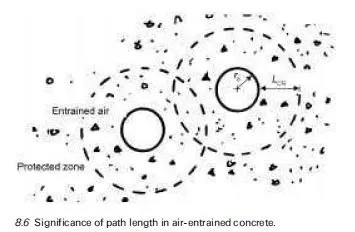The presence of even small amounts of harmful constituents and impurities in aggregates can have a major impact on concrete performance and thus it is important to be able to identify the type and amount of these undesired materials. Table 7.1 provides a broad overview of the various harmful con- stituents of concern and their potential effects on concrete (Kosmatka et al., 2002). The material found in the minus #200 fractions or `microfines’ is particularly of interest, as impurities and clays are often found in this range. It is good practice to routinely measure the amount of microfines, and when concerned about the nature of the microfines, additional testing may be warranted. Simple tests like the sand equivalent test (AASHTO T 176) and methylene blue test (AASHTO TP 57) are useful in assessing the relative amount of `clay-like’ materials and trying to identify smectite clays in aggregates, respectively. Some clays can adversely affect concrete workability and can interact with some polycarboxylate-based superplasticizers (lowering the efficiency of their water-reducing action). The presence of mica, which can be quantified petrographically by point count, is important because excessive mica contents (> 10% in specific size fraction) may lead to increased water demand, segregation, and bleeding (Rogers, 2002).
Most of the potentially harmful constituents described above have an indirect impact on concrete durability. That is, most tend to affect early-age properties such as setting time, workability and water demand, which can in some cases have an adverse impact on the quality of the hardened concrete. If water is added at the job site to compensate for increased water demand, for example, the added water would reduce strength, increase permeability, and decrease long-term durability. Similarly, if the adverse effects led to cracking of concrete (due, for instance, to impurities strongly retarding hydration of a concrete slab that then suffers from plastic shrinkage), the long-term performance of concrete can be reduced.

Other types of impurities and undesirable materials in aggregates can have a more direct impact on concrete performance. For example, cherts, AAR- susceptible aggregates, clay lumps, friable products, and coal can all lead to surface pop-outs (Kosmatka et al., 2002). In addition to those contaminants referred to in Table 7.1, it should be noted that alkalis can be released from some aggregates, exacerbating the tendency for AAR, as discussed in Section 7.7. Also the presence in aggregates of significant amounts of deleterious salts, particularly chlorides and sulfates, will contribute to the risks of corrosion of reinforcing steel (see Chapter 5) and chemical degradation of the cement matrix.


